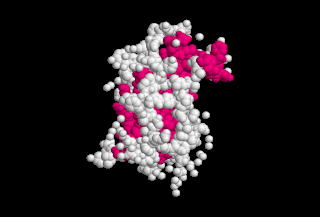Related Research Articles

Dwarfism occurs when an organism is extremely small. In humans, it is sometimes defined as an adult height of less than 147 centimetres, regardless of sex; the average adult height among people with dwarfism is 122 centimetres, although some individuals with dwarfism are slightly taller. Disproportionate dwarfism is characterized by either short limbs or a short torso. In cases of proportionate dwarfism, both the limbs and torso are unusually small. Intelligence is usually normal, and most have a nearly normal life expectancy.

Growth hormone (GH) or somatotropin, also known as human growth hormones in its human form, is a peptide hormone that stimulates growth, cell reproduction, and cell regeneration in humans and other animals. It is thus important in human development. GH also stimulates production of IGF-1 and increases the concentration of glucose and free fatty acids. It is a type of mitogen which is specific only to the receptors on certain types of cells. GH is a 191-amino acid, single-chain polypeptide that is synthesized, stored and secreted by somatotropic cells within the lateral wings of the anterior pituitary gland.

Growth hormone deficiency (GHD) is a medical condition resulting from not enough growth hormone (GH). Generally the most noticeable symptom is that an individual attains a short height. Newborns may also present low blood sugar or a small penis size. In adults there may be decreased muscle mass, high cholesterol levels, or poor bone density.
Growth hormone therapy refers to the use of growth hormone (GH) as a prescription medication—it is one form of hormone therapy. Growth hormone is a peptide hormone secreted by the pituitary gland that stimulates growth and cell reproduction. In the past, growth hormone was extracted from human pituitary glands. Growth hormone is now produced by recombinant DNA technology and is prescribed for a variety of reasons. GH therapy has been a focus of social and ethical controversies for 50 years.
In medicine, precocious puberty is puberty occurring at an unusually early age. In most cases, the process is normal in every aspect except the unusually early age and simply represents a variation of normal development. In a minority of children with precocious puberty, the early development is triggered by a disease such as a tumor or injury of the brain. Even when there is no disease, unusually early puberty can have adverse effects on social behavior and psychological development, can reduce adult height potential, and may shift some lifelong health risks. Central precocious puberty can be treated by suppressing the pituitary hormones that induce sex steroid production. The opposite condition is delayed puberty.
Delayed puberty is when a person lacks or has incomplete development of specific sexual characteristics past the usual age of onset of puberty. The person may have no physical or hormonal signs that puberty has begun. In the United States, girls are considered to have delayed puberty if they lack breast development by age 13 or have not started menstruating by age 16. Boys are considered to have delayed puberty if they lack enlargement of the testicles by age 14. Delayed puberty affects about 2% of adolescents.

Congenital adrenal hyperplasia due to 21-hydroxylase deficiency in all its forms, accounts for over 95% of diagnosed cases of congenital adrenal hyperplasia (CAH), and CAH in most contexts refers to 21-hydroxylase deficiency and different mutations related to enzyme impairment have been mapped on protein structure.

Human height or stature is the distance from the bottom of the feet to the top of the head in a human body, standing erect. It is measured using a stadiometer, usually in centimetres when using the metric system, or feet and inches when using the imperial system.

A prolactinoma is a benign tumor (adenoma) of the pituitary gland that produces a hormone called prolactin. It is the most common type of functioning pituitary tumor. Symptoms of prolactinoma are due to too much prolactin in the blood (hyperprolactinemia), or those caused by pressure of the tumor on surrounding tissues.

Octreotide, sold under the brand name Sandostatin among others, is an octapeptide that mimics natural somatostatin pharmacologically, though it is a more potent inhibitor of growth hormone, glucagon, and insulin than the natural hormone. It was first synthesized in 1979 by the chemist Wilfried Bauer, and binds predominantly to the somatostatin receptors SSTR2 and SSTR5. It was approved for use in the United States in 1988.
The sociology of health and illness, alternatively the sociology of health and wellness, examines the interaction between society and health. The objective of this topic is to see how social life affects morbidity and mortality rate, and vice versa. This aspect of sociology differs from medical sociology in that this branch of sociology discusses health and illness in relation to social institutions such as family, employment, and school, and also interfaces more extensively with sociology of the body. The sociology of medicine by contrast tends to focus specifically on the patient-practitioner relationship and the role of health professionals in society. The sociology of health and illness covers sociological pathology, reasons for seeking particular types of medical aid, and patient compliance or noncompliance with medical regimes.
Short stature refers to a height of a human which is below typical. Whether a person is considered short depends on the context. Because of the lack of preciseness, there is often disagreement about the degree of shortness that should be called short.

Attention deficit hyperactivity disorder (ADHD) controversies include concerns about its unclear existence, causes, perceived overdiagnosis, and methods of treatment, especially with the use of stimulant medications in children. These controversies have surrounded the subject since at least the 1970s.

Breast hypertrophy is a rare medical condition of the breast connective tissues in which the breasts become excessively large. The condition is often divided based on the severity into two types, macromastia and gigantomastia. Hypertrophy of the breast tissues may be caused by increased histologic sensitivity to certain hormones such as female sex hormones, prolactin, and growth factors. Breast hypertrophy is a benign progressive enlargement, which can occur in both breasts (bilateral) or only in one breast (unilateral). It was first scientifically described in 1648.
Rabson–Mendenhall syndrome is a rare autosomal recessive disorder characterized by severe insulin resistance. The disorder is caused by mutations in the insulin receptor gene. Symptoms include growth abnormalities of the head, face and nails, along with the development of acanthosis nigricans. Treatment involves controlling blood glucose levels by using insulin and incorporating a strategically planned, controlled diet. Also, direct actions against other symptoms may be taken This syndrome usually affects children and has a prognosis of 1–2 years.
The Ashley Treatment refers to a controversial set of medical procedures performed on an American child, "Ashley X". Ashley, born in 1997, has severe developmental disabilities due to static encephalopathy; she is assumed to be at an infant level mentally, but continues to grow physically. The treatment included growth attenuation via high-dose estrogens, hysterectomy, bilateral breast bud removal, and appendectomy. In June 2016, after 18 years of searching, Ashley's condition was determined to be the result of a de novo and non-mosaic Single-nucleotide polymorphism in the GRIN1 gene, which is implicated in neurotransmission.

Micropenis is an unusually small penis. A common criterion is a dorsal erect penile length of at least 2.5 standard deviations smaller than the mean human penis size, or smaller than about 7 cm for an adult when compared with an average erection of 12.5 cm (5 in). The condition is usually recognized shortly after birth. The term is most often used medically when the rest of the penis, scrotum, and perineum are without ambiguity, such as hypospadias. Micropenis occurs in about 0.6% of males.
Child euthanasia is a form of euthanasia that is applied to children who are gravely ill or suffer from significant birth defects. In 2005, the Netherlands became the first country to decriminalize euthanasia for infants with hopeless prognosis and intractable pain. Nine years later, Belgium amended its 2002 Euthanasia Act to extend the rights of euthanasia to minors. Like euthanasia, there is world-wide public controversy and ethical debate over the moral, philosophical and religious issues of child euthanasia.

Sotos syndrome is a rare genetic disorder characterized by excessive physical growth during the first years of life. Excessive growth often starts in infancy and continues into the early teen years. The disorder may be accompanied by autism, mild intellectual disability, delayed motor, cognitive, and social development, hypotonia, and speech impairments. Children with Sotos syndrome tend to be large at birth and are often taller, heavier, and have relatively large skulls (macrocephaly) than is normal for their age. Signs of the disorder, which vary among individuals, include a disproportionately large skull with a slightly protrusive forehead, large hands and feet, large mandible, hypertelorism, and downslanting eyes. Clumsiness, an awkward gait, and unusual aggressiveness or irritability may also occur. Although most cases of Sotos syndrome occur sporadically, familial cases have also been reported. It is similar to Weaver syndrome.
Puberty blockers, also called puberty inhibitors, are drugs used to postpone puberty in children. The most commonly used puberty blockers are gonadotropin-releasing hormone (GnRH) agonists, which inhibit the release of sex hormones, including testosterone and estrogen. In addition to their various other medical uses, puberty blockers are used for transgender children to delay the development of unwanted sex characteristics, with the intent to provide transgender youth more time to explore their identity. The use of puberty blockers in transgender youth has been challenged on ethical and medical grounds, causing controversy over the morality and legality of their use.
References
- ↑ Joyce M. Lee and Joel D. Howell.Tall Girls: The Social Shaping of a Medical Therapy Archives of Pediatrics & Adolescent Medicine, Vol. 160 No. 10, October 2006.
- ↑ McDonnell, Cheryl (2016-07-14). "Opinion: Bonsai Babies". Disabilities Australia. Retrieved 2020-12-27.